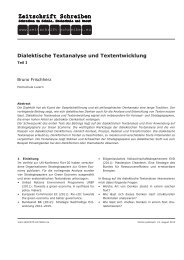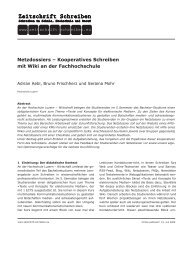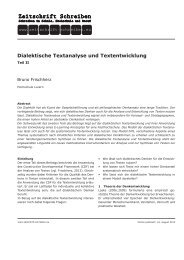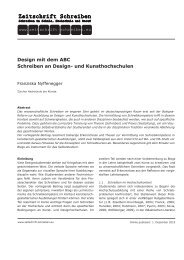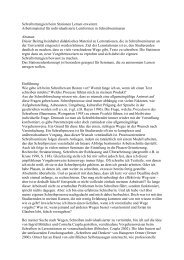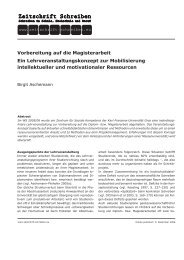Active Reading and the Teaching of Writing - Zeitschrift Schreiben
Active Reading and the Teaching of Writing - Zeitschrift Schreiben
Active Reading and the Teaching of Writing - Zeitschrift Schreiben
You also want an ePaper? Increase the reach of your titles
YUMPU automatically turns print PDFs into web optimized ePapers that Google loves.
organization. Bonnie Meyer noticed that students who<br />
follow what is called «<strong>the</strong> organizational structure <strong>of</strong><br />
text» can determine what is important to remember<br />
<strong>and</strong> achieve a better comprehension <strong>of</strong> <strong>the</strong> whole<br />
text 6 .<br />
Meyer presents five fundamental kinds <strong>of</strong> relationship<br />
between ideas in a text:<br />
1) Cause-effect relationship<br />
2) Problem-solution or Question-answer relationship<br />
3) Comparison relationship (affinities or differences<br />
between elements)<br />
4) List (elements that share <strong>the</strong> same features)<br />
5) Description (a description develops a topic). 7<br />
Analysis <strong>of</strong> <strong>the</strong> table <strong>of</strong> contents <strong>of</strong> a book<br />
How can we proceed to analyze text structure?<br />
First <strong>of</strong> all, we can examine <strong>the</strong> table <strong>of</strong> contents <strong>of</strong> a<br />
book. In every book we can recognize a hierarchical<br />
structure: chapters, sections, paragraphs, <strong>and</strong> so on. If<br />
we have an e-book, we can analyze its structure using<br />
a tool available in <strong>the</strong> well-know text editor s<strong>of</strong>tware<br />
Micros<strong>of</strong>t Word: open <strong>the</strong> menu «View» <strong>and</strong> select <strong>the</strong><br />
option «Outline». If <strong>the</strong> text has been well formatted,<br />
we can immediately view its structure.<br />
After this preliminary analysis, <strong>the</strong> reader can find <strong>the</strong><br />
fundamental idea <strong>of</strong> every single paragraph <strong>and</strong> <strong>the</strong>n<br />
<strong>of</strong> every section <strong>and</strong> <strong>of</strong> every chapter. The main idea <strong>of</strong><br />
every paragraph is useful to find <strong>the</strong> main idea <strong>of</strong> <strong>the</strong><br />
section <strong>and</strong> <strong>the</strong>n <strong>of</strong> <strong>the</strong> chapter <strong>and</strong> <strong>of</strong> <strong>the</strong> whole book:<br />
<strong>the</strong> ideas will form a concept tree.<br />
Meyer proposes some hints to highlight <strong>the</strong> main<br />
concepts in texts:<br />
– Brief summaries at <strong>the</strong> end <strong>of</strong> a section or a<br />
chapter;<br />
– Words used to show <strong>the</strong> author’s point <strong>of</strong> view (e. g.<br />
«unfortunately», «hopefully»…);<br />
– Elements that anticipate an important idea <strong>of</strong> <strong>the</strong><br />
text (e. g. «a key problem is represented by…»);<br />
– Elements that anticipate some information <strong>of</strong> <strong>the</strong><br />
text (e. g.: «in this chapter we are going to solve<br />
two problems, a <strong>and</strong> b…»). 8<br />
The student can use <strong>the</strong>se hints to learn to highlight<br />
important facts <strong>and</strong> evidence from <strong>the</strong> text.<br />
<strong>Reading</strong> purposes<br />
It is very important to explain to our students that<br />
highlighting – like reading <strong>and</strong> writing – is never a<br />
neutral activity, but depends upon our reading purposes.<br />
Many students consider underlining as a boring <strong>and</strong><br />
time-wasting activity. Let’s read <strong>the</strong> experience <strong>of</strong> a<br />
teacher:<br />
Before class began, I happened to walk around<br />
<strong>the</strong> room <strong>and</strong> I glanced at some <strong>of</strong> <strong>the</strong> books<br />
lying open on <strong>the</strong> desks. Not one book had a<br />
mark in it! Not one underlining! Every page was<br />
absolutely clean! These twenty-five students all<br />
owned <strong>the</strong> book, <strong>and</strong> <strong>the</strong>y’d all read it. They all<br />
knew that <strong>the</strong>re’d be an exam at <strong>the</strong> end <strong>of</strong> <strong>the</strong><br />
week; <strong>and</strong> yet not one <strong>of</strong> <strong>the</strong>m had had <strong>the</strong> sense<br />
to make a marginal note! 9<br />
In <strong>the</strong> following exercise, students are encouraged not<br />
only to underline, but before highlighting, to answer this<br />
question: why am I reading this text (article, chapter,<br />
book)? Which information am I looking for?<br />
In order to show <strong>the</strong> relationship between reading<br />
purposes <strong>and</strong> <strong>the</strong> highlighting activity, we can propose<br />
to our students <strong>the</strong> following exercise.<br />
Exercise 3: <strong>Reading</strong> purposes<br />
Every student (or every little group <strong>of</strong> students) gets<br />
<strong>the</strong> same text; each student (or each group) receives a<br />
different reading purpose. For example, we can propose<br />
to read <strong>the</strong> same chapter <strong>of</strong> <strong>the</strong> famous Italian novel<br />
by Aless<strong>and</strong>ro Manzoni (1785–1873) I promessi sposi<br />
(The betro<strong>the</strong>d), that is usually read in every Italian<br />
high school <strong>and</strong> <strong>of</strong>ten also at <strong>the</strong> University. 10<br />
A group is required to highlight important elements<br />
to underst<strong>and</strong> <strong>the</strong> development <strong>of</strong> <strong>the</strong> plot; ano<strong>the</strong>r<br />
group tries to examine Manzoni’s literary style; ano<strong>the</strong>r<br />
group has to find interesting elements to underst<strong>and</strong><br />
<strong>the</strong> story <strong>of</strong> <strong>the</strong> XVII century. The teacher can also give<br />
to ano<strong>the</strong>r group <strong>the</strong> task to highlight <strong>the</strong> text without<br />
a specific purpose.<br />
At <strong>the</strong> end <strong>of</strong> <strong>the</strong> highlighting activity, different results<br />
from different reading purposes are compared in a<br />
discussion with <strong>the</strong> whole class.<br />
From book to hypertext<br />
For some years, students have been required to read not<br />
only books, but also hypertexts. An important difference<br />
between hypertext <strong>and</strong> book is represented by <strong>the</strong>ir<br />
structure: hypertexts have not a linear structure, but<br />
every user can create his own navigation path.<br />
Diane Dee-Lucas showed <strong>the</strong> usefulness <strong>of</strong> overview<br />
structure on study strategies for instructional hypertext;<br />
for example, we can provide a navigation map <strong>of</strong><br />
<strong>the</strong> hypertext to students that are going to examine<br />
it. 11 Dee-Lucas’s study confirmed <strong>the</strong> importance <strong>of</strong><br />
preliminary analysis to improve text (<strong>and</strong> hypertext)<br />
Marinella Lizza: «<strong>Active</strong> <strong>Reading</strong> <strong>and</strong> <strong>the</strong> <strong>Teaching</strong> <strong>of</strong> <strong>Writing</strong>» www.zeitschrift-schreiben.eu 10.10.2007 Seite: /8



